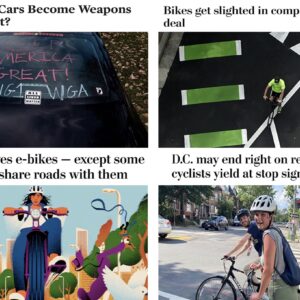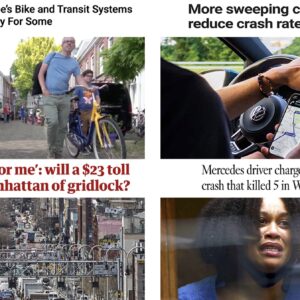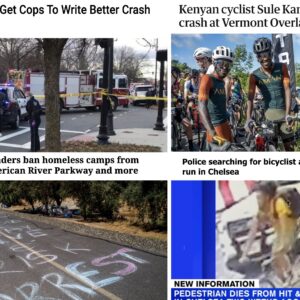Special Tuesday double edition! Here’s the bike news from around the word that caught my eye in the last two weeks and one day:
– A new study finds that cities with a high rate of bicycling enjoy safer streets — and not just for people on bicycles.
– Some parts of London now have more bicycle traffic than car traffic.
– In Toronto, a new bike lane on a major street is slated to be removed.
– In Mozambique, bicycles are praised for being integral to the nation’s economy.
– A report on European cities’ efforts to make driving the least convenient way to get around.
– A Netherlands study finds it’s cheaper to build cycling infrastructure than it is to not build it.
– The mayor of Los Angeles has declared that a 1,680 mile connected bicycle network be built to improve the city.
– Two towns in North Texas are making plans to build more bike lanes, with varying responses.
– Several people who were injured while bicycling through a tricky stretch of infrastructure in Seattle have offered to pay to fix it themselves out of the legal settlements they’ve won from suing the city over the crashes.
– The New York Times looks at why that city’s cycling population counts so few women in its ranks, and concludes that safety is a more important issue than fashion. (I also recently tackled this topic elsewhere, with somewhat different conclusions.)
– Shenzhen, China has banned electric bicycles because of safety concerns about their speed and lack of noise.
– The legal battle over the hit and run in Eagle Creek, Colorado has concluded, with a controversial plea bargain being upheld by the judge in the case. The high profile Denver wealth manager who left the scene after striking a prominent anesthesiologist had been offered the reduced charges due to his social standing, resulting in widespread outcry.
– In Vermillion, South Dakota, a beloved community leader with advanced Parkinson’s rode his recumbent tricycle across the state to raise awareness about the disease and the benefits of bicycling for those who live with it.
– A Tour de France competitor plans to complete the race on a (mostly) vegan diet.
– Travelers on one of Minneapolis’ bike paths now can make use of a bicycle self-service kiosk complete with vending machine and repair stand.
– A man’s tiny house, destined to be his residence during the week-long Burning Man fest, is pulled by a bicycle and powered by solar and wind energy.
– The so-called New York Cycling War, debunked and investigated.
– A long article about the growing popularity of bicycling for transportation from a marketing and industry perspective.
– An interview with the artists behind the Yehuda Moon comic.





Thanks for reading.
BikePortland has served this community with independent community journalism since 2005. We rely on subscriptions from readers like you to survive. Your financial support is vital in keeping this valuable resource alive and well.
Please subscribe today to strengthen and expand our work.
Nice links..
I love the article about safety in numbers. How I long for the day when there is enough bike traffic in Portland that I feel like I can ride about without a styrofoam hat.
the sentence in the colorado hit and run, weak as it is, does forbid erzinger to drive a car for a year, and requires him to either do sixty days of work release in county jail or forty-five consecutive days of charitable work — which, as the linked article notes, would require him to take a leave of absence from that real important work he does, um, investing money for rich people. i wonder which he will choose.
The WSJ article is an anti-bike rant disguised as a pro-bike piece.
“And cyclists can’t be exempt from criticism.”
False equivalence. There is very little criticism of petro-motoring in the media.
“A bike rider in New York City has a responsibility to be not just an advocate but an ambassador.”
Poppycock. Do motorists or pedestrians have to be advocates and ambassadors? No they don’t…they are just getting from point A to B.
“There’s nothing worse than a haughty biker who thinks the rules don’t apply to him or her.”
Straw man and stereotyping. Given that the vast majority of pedestrians and motorists break traffic statutes, most people clearly think (some) rules don’t apply to them.
“Actually there is something worse: a haughty biker without a helmet”
Are motorists and pedestrian also haughty because they don’t wear helmets? And nothing worse? I mean…really???
“yelling out of the corner of his or her mouth for people to get out of the way.”
Are cyclists supposed to meekly whisper (and bend over) when someone is in their legal right of way. I think not.
“Slow down”
If a cyclist is going at a legal speed appropriate for conditions then there is absolutely no requirement to slow down (and enjoy the ride, smell the fresh air, relax, meditate, etc.)
“lunatic”
Very classy.
One man’s lunacy is another man’s protected religion.
The most reliable strategy would then be to prevent the indoctrination of younger generations in the ways of irrationality and illogic and wait patiently for those impervious to reason to “pass” from natural causes.
Acknowledging their rage with rage is a validation of their opinion in absence of fact or empirical evidence.
The fighting the effect of their actions is necessary but the only action that will stop an irrational person is force. The sort of overpowering force that stops another’s actions and speech and possibly their life.
The high road or the low road: choose your adventure!
The report on European cities’ efforts to make driving the least convenient way to get around made me think Portland should close Naito Parkway along the waterfront. People still find ways to get around the city when it is restricted for events.
Go bold: make every 1 of 2 or even 2 of 3 streets in the downtown core pedestrian/less-than-5MPH zones.
Portland’s blocks are plenty short for peds and TOO short for autos; if we reduce the number of intersections and possible turnouts potential collisions will go down.
“The report…”(BicycleDave), a, New York Times article, ‘Across Europe, Irking Drivers Is Urban Policy’ NYtimes/Elizabeth Rosenthal, was interesting, but an across the board accounting without a lot of specifics as to how some of the methods described work overall for the areas where they’ve been put in effect.
Taking out underpasses and closing multiple blocks of urban areas to motor vehicle travel. That can’t work without major revisions to community infrastructure planning. The article noted that Europe has a better mass transit infrastructure. Portland, by comparison, despite MAX, WES, and Streetcar…and buses…barely has mass transit infrastructure that would support the kind of motor vehicle travel reductions the NYtimes article talks about.
What parts of Downtown Portland (besides PSU…already closed.) could realistically be closed to motor vehicle use(Let’s say, a 10 block square area, roughly the size of Ladd’s Addition.)? Maybe…the West End (Stark St area.)? It’s got hotels…smaller than Hilton and Marriot, but still, people have to be able to come and go to those places. People would walk and bike. How much expansion of bus and streetcar service would be required to compensate for the loss of motor vehicle access?
Elly, on the NYT gender gap story, I hear anecdotally from a lot of female riders that they gave up riding to work when they had to take care of their kids–so I think your point about childcare & time management might be on point.
I do agree with the New York Times in seeing NY as its own animal where trends may be skewed (my clan hails from NYC & I just returned from a trip through the more bike-centric hoods). Commuters are much more aggressive & careless; the infrastructure vastly inconsistent. Women’s concern about safety in NY isn’t timidity, it’s fully rational. The safety issue is exacerbated by foolish riding habits by a few highly visible people and the campaign by “Cycle Chic” and others to make helmets look unfashionable and a sign of weakness.
Also, yes, New Yorkers (men included) really are the most fashion-obsessed people on the continent.